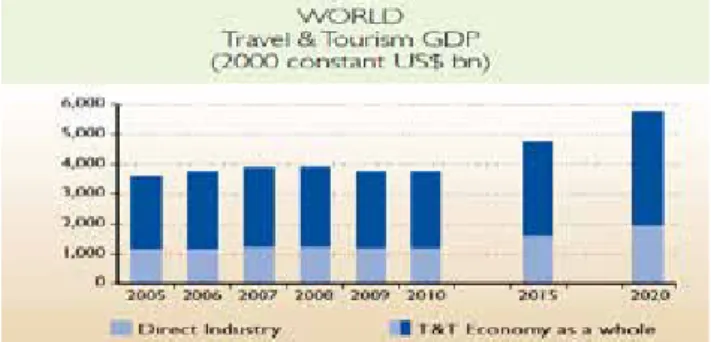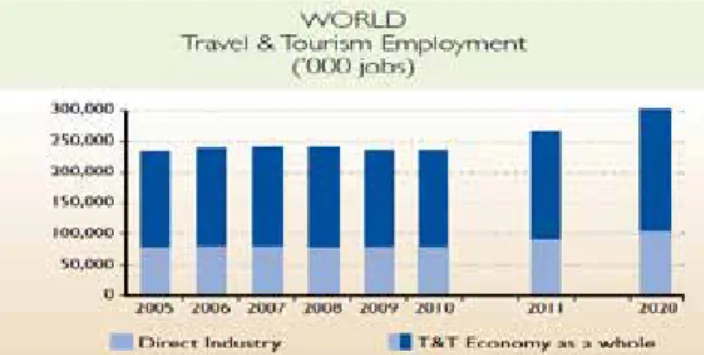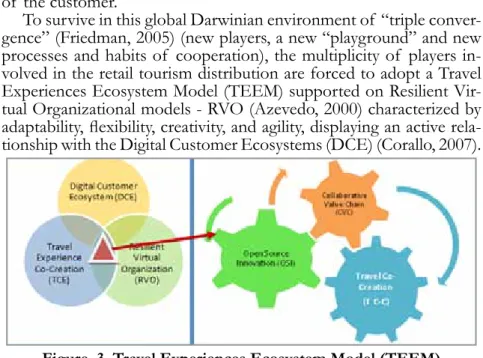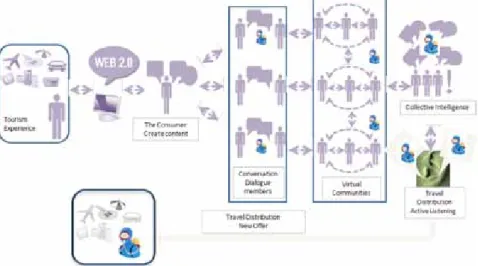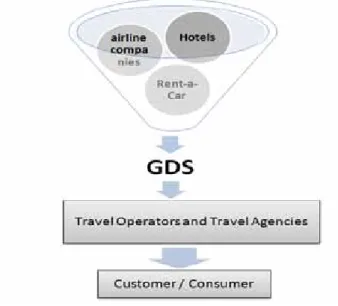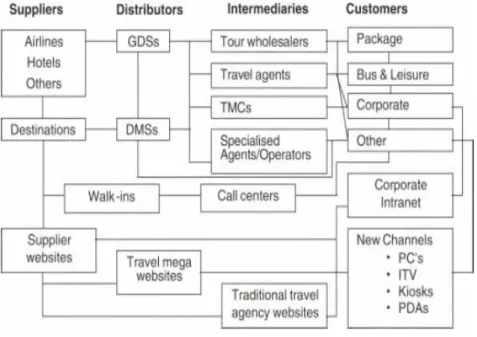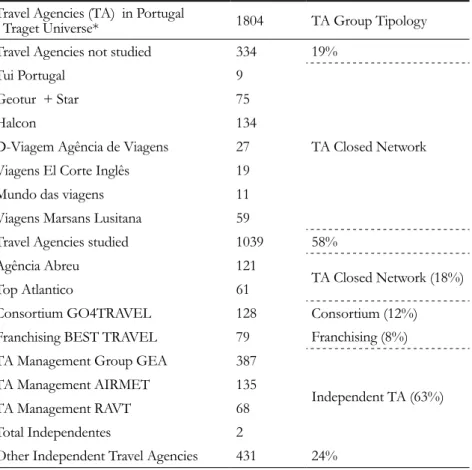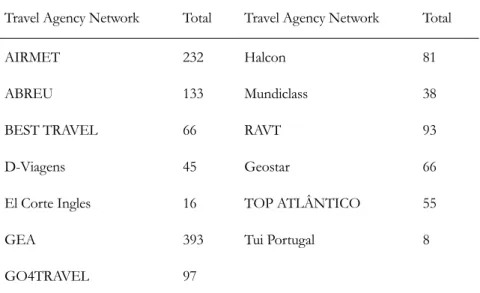95 www.ejthr.com
Research EJTHRTourism
European Journal of
Tourism, Hospitality and Recreation
Research EJTHRTourism
European Journal of
Tourism, Hospitality and Recreation
© 2011 Polytechnic Institute of Leiria. All rights reserved Printed in Portugal
TrAVEL EXPEriENCE
ECOSYSTEM MOdEL
Building travel agencies’ business
resilience in Portugal
1Josefina Salvado
UniversityofAveiro,Portugal
AbstrAct: The Portuguese tourism distribution recognizes in the digital economy drivers
- based on e -business, collaborative networks and information exchange - an incentive to pro-ductivity and rendibility, leading to sustainable competitive advantages. Travel agencies live currently in a darwinian business -oriented environment, where only resilient entrepreneurs are able to survive. This framing allows the genesis of a new theoretical archetype of travel agencies, the “TEEM -Travel Experience Ecosystem Model” observing several organizational strategies and concepts, such as Resilient Virtual organizations, digital Customer Ecosystems, Collaborative Value Chain and Co -Creation travel experiences, as well as new types of open Source Innovation trough Social Web. Keywords: digital economy drivers, tourism distribu-tion, travel agencies, business resilience, co -creation.
resumen: La distribución turística en Portugal reconoce en los controladores de la econo-mía digital - basado en e -business, redes de colaboración e intercambio de información - un incentivo a la productividad y rentabilidad, dando lugar a ventajas competitivas sostenibles. Las agencias de viajes viven actualmente en un entorno darwinista orientada a los negocios, donde sólo los empresarios resilientes son capaces de sobrevivir. Este marco hace posible la génesis de un nuevo arquetipo teórico de las agencias de viajes, el “TEEM -Travel Experience Ecosistemas Model” la observación de varias estrategias de organización y conceptos, como por ejemplo, “Resilient Virtual organizations”, “digital Customer Ecosystems”, “Collabora-tive Value Chain” y “Co -Creation” de experiencias de viajes, así como nuevos tipos de “open Source Innovation” a través de web social. Palabras clave: vectores de la economía digital; dis-tribución turística; agencias de viajes; resiliencia de negocios, co -creación.
resumo: A distribuição turística reconhece nos drivers da economia digital – baseadas no e -business, no trabalho colaborativo e na troca de informação - um efeito incentivador da pro-dutividade e da rendibilidade, conduzindo a vantagens competitivas sustentáveis. As agências de viagens vivem actualmente num ambiente de negócios darwiniano, onde apenas empre-endedores resilientes conseguem sobreviver e crescer. Este enquadramento torna possível a génese de um arquétipo de agência de viagens, que designamos por “TEEM -Travel Experien-ce Ecosystem Model”, sustentado em vários conExperien-ceitos e estratégias, tais como organizações Virtuais Resilientes, Ecossistemas digitais dos Consumidores, Cadeias de Valor Colaborati-vas Collaborative e da Co -Criação de experiencias de viagens, e ainda a adopção de sistemas abertos de inovação usando as redes sociais. Palavras -chave: Vectores da economia digital; distribuição turística, agências de viagem, negócios resilientes, co -criação.
Josefina Salvado is a Phd candidate at University of Aveiro. For 20 years she has worked in distribution Strategy and Consulting in Travel distribution.
INTRodUCTIoN
The tourism sector is an important engine of the world’s economy, generating wealth and creating jobs, crucial to a sustainable growth and development. For decades, tourism contributed greatly to globalization, developing world economies and arousing new destinations.
Tourism has been contributing to the development of new and cheap-er means of transportation, as shown by the emcheap-ergence of low cost air-lines companies.
According to the World Tourism organization (UNWTo), interna-tional tourist arrivals reached 924 million in 2008, representing a growth of 2 percent compared with 2007. The World Travel & Tourism Coun-cil (WTTC) estimates that, from direct and indirect activities combined, the T&T sector now accounts for 9.9% of global GdP, 10.9% of world exports, and 9.4% of world investment.
The European Market Share is 52%, followed by Asia / Pacific (21%), the Americas (16%), the Middle East (6%) and Africa (5%). Since 2007, Asia -Pacific, Africa and the Middle East have been challenging the “old continent”. However, Europe continues with most of the arrivals (52%) and revenue (67%). According to WTTC (2010) data release, growth in tourism worldwide during the period 2008 -2009 was negatively influenced by economic and financial instability - that has spread around the world - where the price of fuel and the financial crisis had an accelerating effect.
Figure 1. T&T GDP contribution
In 2009 T&T business suffered from the global crisis, with a GdP contracting by 4.8%, losing almost 5 million jobs. However, the World Tourism accounts for 235 million jobs (8.2%). In 2010 a 0.5% growth is expected, reflecting an expansion of 9.2% ($ 5.751 billion dollars) in world GdP to 9.6% ($ 11.151 billion dollars) and projecting oMT 1.6 billion passenger arrivals in 2020. In the Euro Zone a similar trend was noticed.
Figure 2. T&T Employment Contribution Source: Travel_Tourism_Economic_Impact_2010, pag. 3.
It is observed that over the years, tourism has shown strength and resilience, surviving major turbulence effects, such as financial mar-kets, terrorism, pandemics, fuel prices and carriers’ rates. The result of these inherent cycles in the globalized market is the changing image of tourism. As noted by Poon (2006), “international tourism is changing and will be more flexible, customizable, targeted and integrated, aban-doning the format of mass tourism, standardized in the 70s”.
The theme developed in this paper, falls within the area of Travel distribution (Td) in Portugal, focusing on Travel Agencies (TA) busi-ness, seen as part of an accelerated referentials change. In the geopo-litical domain, the world is no longer bipolar, as a result of an informa-tional revolution. The Internet, global television channels and mobile telecommunication networks, contributed to a flatter world. The eco-nomic area living inside globalization faces an accelerated capital mo-bility and production factors. The migration field highlights the spatial mobility of populations, often targeted for new investment opportuni-ties or moments of joy. In the tourism field, trends point up to social fragmentation and individualism - the development of virtual commu-nities, the exchange of experiences between Web traveler tribes, and the search for information on the Internet - are generating accelerated geographical mobility and virtual communities, creating new demand profiles. Some authors highlight the demographics and psychograph-ics of the new consumer:
• More individualistic, involved or implicated, independent and informed, with an exaggerated sense of freedom (any-time, anywhere) and increasingly demanding (WIIFM - What’s In It For Me?);
• More conscious of their power and their rights, challeng-ing the suppliers;
• A growing shortage of time, attention and confidence, result-ing in higher need for convenience, authenticity and credibility;
• A more advanced average age, the result of a lower birth rate and greater life expectancy, determining the prevalence of more conservative values;
• Children more able than adults to use computers and surf the Internet, having perceptual abilities better adjusted than adults to the powerful stimulus of visual electronics;
• An increasingly important role of women in economic and social life;
• A more diverse geographic, ethnic and cultural consequence of the increasing globalization of human society;
• Weakened social rules and new socio -economic structure; • Increased environmental concerns and matters of personal and social security, higher stress levels.
With these or other characteristics, the new consumer or internet consumer is undoubtedly an emerging market, along with other emerg-ing categories such as the elderly, immigrants, Net Generation, or con-sumers with alternative preferences.
Modahl (2000) proposes the new technographics consumer, offering 10 cyber -consumers segments, which result from crossing the behavior variables towards technology (optimistic or pessimistic), income (high or low) and primary use motivation (career, family or entertainment).
Consequence of all these factors, travel agencies in Portugal rec-ognize in digital economy drivers an incentive effect of productivity and profitability. The tourism industry was among the first sectors to embrace B2B (Business to Business) and B2C (Business to Consumer) business support systems, such as the reservation systems GdS - Glo-bal distribution Systems, or systems to support management and de-cision, such as Gestravel, Sigave, Gestav, Nonious, or the self -booking tools (SBTS) supported by Web systems. This ICTs atmosphere in-creases the range of new channels, available to consumers and retailers.
Buhalis (1998) said that “tourism is inevitably affected by the tech-nological developments and none of the players involved can escape its impact.”
TRAVEL AGENCIES: TRAVEL EXPERIENCES ECoSYSTEM ModEL (TEEM)
The above discussed issues redraw important trend lines for tour-ism distribution, both on the demand side or the supply side. They are aided by technological dynamics considered enablers of business, from productivity growth and sustainable competitive advantage. Seeking a sustainable competitive advantage has become a major challenge for organizations.
The companies’ prosperity lies in “how to differentiate” to get com-petitive advantages. The comcom-petitiveness and productivity keys are based on knowledge acquisition - through the simple and fast access to better information – and the way to improve the collective intelli-gence of the traveler’s tribes. These gains reflect a gradual reduction of labor input to achieve outputs. The ICTs, the Internet and Web 2.0 are strong contributors to the “atoms” replacement with “bits” in or-ganizational settings.
Buhalis (2002) observed a profile change of the travel agent, from an “infomediary” (information broker) to become a consultant “Ino-mediador” (innovation middleman). The new generation of travel In-termediaries, turn into “eMediaries” (Buhalis, 2002), giving rise to a new travel agent - travel consultant – an interactive broker between the consumer and the tour operator.
These travelers’ advisers are aware that the value is only generat-ed when a company creates an advantage for the buyer and when he realizes a purchasing benefit, compared with other similar item. For Porter (1985), competitive advantage cannot be understood by look-ing at the company as a whole, but it comes from the numerous and various activities that comprise it. An attention shift from supplier to the customer and their singularities becomes evident. The heavy em-phasis is on balancing the values: for the time, money and experience of the customer.
To survive in this global darwinian environment of “triple conver-gence” (Friedman, 2005) (new players, a new “playground” and new processes and habits of cooperation), the multiplicity of players in-volved in the retail tourism distribution are forced to adopt a Travel Experiences Ecosystem Model (TEEM) supported on Resilient Vir-tual organizational models - RVo (Azevedo, 2000) characterized by adaptability, flexibility, creativity, and agility, displaying an active rela-tionship with the digital Customer Ecosystems (dCE) (Corallo, 2007).
Figure 3. Travel Experiences Ecosystem Model (TEEM) According to Wikipedia, an ecosystem is a system where its members benefit from each other’s participation via symbiotic relationships
(posi-tive sum relationships). The term has its origins in biology, referring to the self sustained systems. When applying the concept to business, an ecosystem can be viewed as a system where the relations between dif-ferent players become self sustaining and mutually helpful and closed.
Figure 4. Digital Business Ecosystem
The purpose of these ecosystems is to generate entrepreneurial advantages along the Collaborative Value Chain (CVC) (Greenberg, 2009). The effect of leveraging synergies from alliances or informa-tion partnerships increases core activities skills, reducing costs through economies of scale and improving diagonal integration (Poon, 2002).
This model assumes that users’ habits on the Web aren’t that differ-ent from customers’ habits in a store. Visitors glance at each new page, scan some of the text, click on the first link that catches their interest
and comment or send the link to a friend (buzmarketing). The
Inter-net has the potential of providing service to the consumer that com-plement the domain of face -to -face travel agents. The rapid adoption of the Internet as a distribution channel and a medium for marketing communications has instigated firms to experiment innovative ways of interacting with consumers in computer -mediated environments.
The Social Web offers enormous potential for developing customer
relationships and encouraging the exchange of opinions / information between communities.That will force all operators and travel agents to invest heavily in the online segment.
We are speaking about network communication involving all stake-holders. These assumptions lead to new business settings with focus on the customers and their decision -making process, and on building USP - Unique Selling Proposition (Richardson, 1993). This framework allows the genesis of a new archetype of a travel agency, designated by “Travel Experience Ecosystem Model” (TEEM).
According to Cornelis (1988) “society’s system of social decision is changing to make way for one driven by communicative self steering”. The traditional top down approach makes way for dialogues between equal partners. As a result, customers are gaining more power and con-trol. In Tourism, competition has been based for a long time on product and company centric led innovations to increase product variety or to in-crease uniqueness. This is being taken over by the co -creation experience as a basis for value and as the future of innovation, according to Prahalad and Ramaswamy (2004).The tourism co -creation experience results from the interaction of an individual at a specific place and time and within the context of a specific act.
We are speaking about “culture of tourism” (Urry, 1990). A real co--creation experience is neither company nor product centered. The better companies focus on the consumer context and match with the individual’s living and using environment, which increases the co -creation experience value. Interestingly, for many people in the developed world, time spent on leisure and tourism has become an essential part of their quality of life (Csikszentmihalyi and Hunter 2003). Especially during their free time people express a quest for ever more unique experiences reflecting their own personal stories (Binkhorst, 2002, 2005a, 2005b). Binkhorst (2006, p.4 ) argues that the experience of the co -creation itself is the basis of a unique value for each individual. Strangely enough, the biggest experi-ence generator, i.e., tourism, is not yet one of them.
To build Co -Creation travel experiences in an efficient way it is cru-cial to use open Source Innovation (oSI) (Chesbrough, 2006) through the Social Web. Technology, which will empower consumers ever more to co -create their ‘Consumer to Consumer’ (C2C) tourism experiences. Technology influences tourism experience networks tremendously and changes them continuously. Both the searching and booking of tourism experiences is increasingly done on -line, taking over from the traditional electronic tourism intermediaries. Today there are 1.5 billion Internet us-ers worldwide and it is estimated that this figure will grow 50% by 2015. That will force all operators and travel agents to invest heavily in the on-line segment.
In 2020 the generation born in the digital age (Net Generation) en-ters the labor market, so the change in consumption patterns and behav-ior will be amazing. The development of technology will determine the emergence of new channels. The travel agencies sector believes that the
current phase is in transition to a more global tourism and more digital one. The online will determine the entire business model and emerging countries will become the main source of global growth of tourists, es-pecially China, India and Russia.
The approach of customers across multiple channels and the use of social networking can be powerful tools to capitalize on the brand, cus-tomize the connection to customers, tailoring contents and having more direct access and real feedback from their customers.
In the 2010 survey done by APAVT ( the Portuguese travel agencies association), almost two thirds of its members (63%) admitted that the supply of online products will increase in the coming years, while 44% said they will use social networks to advertise the company.
The exploring co -creation experiences in the travel agencies sector is only at the beginning. It is common sense that tourism is a very impor-tant, if not the most important experience generator and economic mo-tor of many societies. But, the Travel agency activity with its enormous number of small stakeholders is not yet used to consider experience en-vironments and experience networks in which tourists - considered as co -create partners - play a central role. Nor is it common to invest in in-novative research or interactive ICT’s as a basic tool for business develop-ment, as is already done in some other sectors.It was verified that inside the independent travel agencies group in Portugal, the use of sophisti-cated ICT is still weak, because only 74.8% have a Web Page and only 57.8% are selling on the Web.
38% of travel agents don’t sell on the web because of the economic viability, the distrust in the payment system and the fact that consum-ers cannot use a PC; 74.31% of independent travel agents still consider selling products on the Internet unfair. The products and services with greater acceptance on the Web, for both clusters, are the tour packages, hotel stays and airline tickets.
Figure 6. Travel Agencies in Portugal: web presence and selling products
It was found that the used tools and the offered information on their portals were essentially informative and hardly interactive.
The sophistication degree of travel agencies’ ICT was very poor, giv-ing little inspiration for travellers planngiv-ing their trips.
When you progress in and if you want to know the extent of us-ing TRS - Travel Recommender Systems, recommendus-ing itineraries, we found insufficient knowledge and use of this tool to inspire the traveler about destination areas or it even cannot help tourists planning the trip. The range of other products and services from the tourism experi-ences value chain (events ticketing, cultural or sportive proposals) was reduced. In Portugal, Tour Packages, Hotels and Airline Tickets are the Top 3 of Web selling products.
other ordinary ICT tools are being used by travel agencies, such as the e -mail, direct Mail, Web advertising, travel operator links, showing that 96.3% of respondents have a PC network in the company and 44% of agencies have 5 PCs connected to the Net. These facts are forcing com-panies even more to compete not on price but on service. When inves-tigating their core value proposition, successful travel agencies will put their customer - not their company - first when asking the question – what can I do to make the experiences/emotions of my customers thrilling?’ TRAVEL AGENCIES IN PoRTUGAL ANd ICT’S CoMPETI-TIVE IMPACT
Buhalis and Licata (2002) confirm that the ICT and Internet offer the opportunity for companies to develop closer relationships with cus-tomers. In their study they mentioned that ‘actually the Internet is offering
a better service and experience for the consumer as their interaction with tourism or-ganizations can be more meaningful. … a number of travel companies already offer specialized support through their calling centers and enable consumers to ask specific questions to a product/property/destination specialist’.
The Internet, IdTV and mobile communication devices are the three most significant ePlatforms for the near future. This issue becomes very important in the tourism sector, with a long history of internationaliza-tion experience. These technological developments will make meaning-ful dialogues possible with each individual customer and besides, they provide an experience environment where innovations in tourism can be based on the co -creation experience.
The Internet has the potential of providing a service to the consumer that basically complement the domain of travel agents. Sigala (2003, p. 194) states: “By connecting different buyers and sellers through a shared network and providing some searching tools, electronic networks help buyers to quickly, conveniently and inexpensively evaluate the offerings of various suppliers and seamlessly and efficiently finalize and conduct any transactions.” Personal computers, self -service kiosks and interac-tive television have entered the tourism distribution system, changing the way travel agencies build up their business.
Buhalis and Licata (2002) refer to the new distribution channels driven by the Internet as the new tourism “eMediaries”. We have been watch-ing a progressive change in the tourism mediation philosophies. Because of the intensive use of ICTs, the traditional model (intermediation) was transformed into another where customers are closer to the suppliers (disintermediation). With ICT growth, the tourism industry was being driven towards consolidation and integration, developing more flexible products and services and using the Web as a new distribution channel. Watching the next image, based on Lubbe (2005), we can observe that the ICT have been transforming travel distribution in a much more complex issue. These changes were and are determined by advances in technology, particularly the Internet; parallel changes in consumer de-mands -with customers becoming more independent, sensitive, “green” and harder to please - and the deregulation of airlines.
According to the Portuguese strategic tourism plan (PENT), the new business models point to disintermediation strategies. The Push strategy is defined as “to push the product, by operators and travel agents to cus-tomers” while in the Pull strategy, “the company is driven by the needs expressed directly from their end customers”. Inside Pull Strategies, the main marketing mix components are: advertising and sales promotion as well as strong relationship with the market.
Note that the traditional system of tourism distribution was based on a linear model, where products and services were going from supplier to consumer, directly or indirectly through intermediaries, such as travel agents. The conventional travel agent was considered as a supplier’s agent, to whom a commission/fee for the service’s sale is paid. In this model, travel agents play an intermediary role, bringing together a supplier port-folio of products and services, and delivering them to end consumers.
The traditional brokerage of Tourism distribution - Td generally includes three participants: the suppliers (airline, hotel or rent -a -car) that offer the product through the reservation systems, the GdS – Global distribution System. 83% of the market share of Global dis-tribution systems in Portugal is held by Galileo and 17% by Amadeus. The GdS provide full access to inventory and also to tourist supplier information, such as travel operators (To) and travel agencies (TA) that manage the transaction on behalf of client.
Figure 8. The new tourism distribution model (Lubbe, 2005) The travel industry has moved towards consolidation and integra-tion, the development of more flexible products and services and the use of the World Wide Web (WWW) as a new distribution channel for tourism suppliers (Lubbe, 2005).
In the Supply side, the Internet has the ability to complement the provided service by travel agents. In fact, different providers / opera-tors can be connected, can offer faster service to a full range of cus-tomers; can gain operational efficiency; can improve brand image and become closer to the market. From the demand side, the Internet can be a vehicle for collecting customers’ points of view and preferences, earning their confidence (customers become company apostles) engag-ing them in the process of co -createngag-ing travel experiences. To survive in this darwinian environment, travel agencies must be: agile, resilient and adopt virtual structures, focus on core business and customer
needs, developing cooperation between economic actors (reinforcing the concept of networks), build up innovative ICT, in order to take advantage of the differentiation factors and capture sustainable com-petitive advantages.
This paper proposes a competitive model for independent travel agencies, responding to the following question: How can Travel Agen-cies build competitive resilience in the darwinian business environ-ment?
The methodology followed was one of the types mentioned by Bray-man (1988), which recommends a quantitative macro -scale structure (in this case 1804 travel agencies) and a qualitative research - analysis of travel agency websites. The exploratory research followed three phases, the data having been obtained through questionnaire surveys, conducted on a sample of 1039 travel agencies in Portugal (58%) of the total universe (1804) representing all the clusters significantly.
Figure 9. Evolution of the number of travel agencies between 2002 e 2008 (Salvado, 2009)
The evolution of the number of travel agencies in Portugal has been influenced by the economic, political, social, environmental and technological cycles. Travel agents in Portugal have not escaped from this intense wave of the ICT use. There is a cumulative growth average of 4.25% of the number of travel agencies in the period 2005 - 2008.
The main Travel Agencies’ typology in Portugal is SME -small and
medium enterprises, 49.7% are micro companies - (belonging to the cluster of independent travel agencies) and 38.5% are medium com-panies (linked to the cluster of closed groups of travel agencies), be-coming an important segment in the tourism distribution sector. The small size is a handicap for resources (financial, expertise, materials, in-novation, marketing, etc.). However, the sector provides solutions that generate employment and offers benefits of economic development.
The most common corporate type is a limited company with 59.3% and 97.5% Portuguese capital. Independent travel agencies put empha-sis on outgoing activity, with 3 to 5 professionals in their shops, while the ones in the closed policy networks, diversifying fields of action (outgoing, incoming and operator), have 11 to 20 employees.
Table 1. Travel agency activity
Travel Agencies (TA) Tipology Count %
outgoing 315 98% Specialized TA 56 17% Incoming 173 54% Tour operator 172 53% Bus specialist 8 2% Source: Salvado (2009).
In this study, the current 1804 travel agencies in Portugal in 2008 were divided into four clusters according to the organizational group-ing criteria on the market: closed policy networks, consortia, Franchise and Independent Agencies.
Table 2. Travel agencies divided into clusters
Travel Agencies (TA) in Portugal
- Traget Universe* 1804 TA Group Tipology Travel Agencies not studied 334 19%
Tui Portugal 9
TA Closed Network
Geotur + Star 75
Halcon 134
d -Viagem Agência de Viagens 27 Viagens El Corte Inglês 19
Mundo das viagens 11
Viagens Marsans Lusitana 59
Travel Agencies studied 1039 58%
Agência Abreu 121
TA Closed Network (18%)
Top Atlantico 61
Consortium Go4TRAVEL 128 Consortium (12%) Franchising BEST TRAVEL 79 Franchising (8%) TA Management Group GEA 387
Independent TA (63%)
TA Management AIRMET 135
TA Management RAVT 68
Total Independentes 2
other Independent Travel Agencies 431 24%
Closed Policy Networks, like Star + Geotur, Mundo das Viagens, Abreu and Top Atlântico, Tui, Halcon, Marsans, d -Travel, El Corte Ingles, comprising 516 travel agencies (29% of the total universe and 18% of respondents);
Consortia as Go4Travel with 128 travel agencies (7% of the uni-verse, and 12% over the universe of those surveyed);
Franchising as Best Travel with 79 travel agencies (4% of the Uni-verse and Total 8% of respondents);
Independent Agencies and Management Groups (RAVT, GEA and Airmet) Mundiclasse, with a total of 1,081 travel agencies (60% of the Universe and 63% total respondent universe). Both types were included because the management groups are composed entirely of independent travel agents.
A clear conscience of the existence of a business environment classified by Tribe (2003) with 4 d’s, hard, devastating, dynamic and distinctive was observed in the travel agencies sector in Portugal. The strategies adopted to survive in this turbulent atmosphere differed ac-cording to the travel agency cluster (closed group policy or independ-ent agencies).
Table 3. Travel agencies Network
Travel Agency Network Total Travel Agency Network Total
AIRMET 232 Halcon 81
ABREU 133 Mundiclass 38
BEST TRAVEL 66 RAVT 93
d -Viagens 45 Geostar 66
El Corte Ingles 16 ToP ATLÂNTICo 55
GEA 393 Tui Portugal 8
Go4TRAVEL 97
Total 1323; Total Travel Agencies in Portugal 2122
Source: TP - Turismo Portugal, “Licensed Travel Agencies in 10/2010”.
In the research, a strong focus on the core business was found , choosing innovative network cooperation forms between players (65% of travel agencies is integrated collaborative network: 52% in
man-agement groups 27% in vertical networks, 12% Franchising and 8% consortium).
It was possible to recognize in this study some ICT impacts for business management processes and value and supply chains of trav-el agents.
Figure 10. Market Share - Travel agency collaborative network When asked about travel agencies’ new generation attributes, opin-ion diverged by cluster:
• Travel agency vertical networks: put emphasis on the fact that “the Internet enables a better Product & Service dissemi-nation” and “Internet replace the brochure on sale”.
• Independent travel agents have a different perception, giving more value to “strengthening the relationship with partners (collaborative networks)” followed by “frequent use of com-munication systems and multimedia”. In third place they point to the “frequent use of extranet and transaction reporting function”, followed by “a possible sale online billing increase”. Independent Travel Agents have e -commerce less implanted in their business model, using only the most basic ICT such as email, Web pages with information on institutional and informational na-ture. A remarkable awareness among managers of travel agencies in
Portugal was foundin terms of the use of innovative ICT in order to
become more efficient and meet customers’ singularities. But when asked about sophisticated ICT recommending itineraries as TRS -
Travel Recommender Systems, we found insufficient knowledge and use of this kind of tools.
As Buhalis, said “The future success of tourism organizations … will be determined by a combination of innovative management and marketing, intellect and vision, as well as strategic use of advanced Its”. (Buhalis, 1998).
TRAVEL AGENCIES - FoCUS oN RESILIENCE
“…it is not enough to be just selling a consolidated package of ac-commodation, air and entertainment tickets. Anybody can do that, but to be a travel agent of the future, the key is to differentiate and to grow their businesses these agents must have unique products and a strong brand with multi -channel competency…”
don Birch, CEo and President of Abacus International, (2008) According to Turban et al. (2004), the digital Economy (also called the Internet economy, new economy and Web economy) involves a dig-ital technology -based economy, embracing digdig-ital communication net-works, computers, software and other related information technologies, which provide a global platform from which the individuals and organ-izations interact, communicate, collaborate and research information.
As referred to by Poon (2002) “The information technology facili-tates the production of new, flexible and high -quality travel and tourism services that are cost competitive with mass, standardized and rigidly packaged options. IT helps to engineer the transformation of travel and tourism from its mass, standardized and rigidly packaged nature into a more flexible, individual -oriented, sustainable and diagonally in-tegrated industry”.
Lockwood e Medlik (2003), point to a proliferation of alliances and partnerships around the world, between business and leisure travelers, suppliers and consumers, through information technology and e -com-merce links. Clearly a strong growth of business tourism and low -cost services, as opposed to full service and high quality.
Michael Rothschild showed in the 1990s’ in his work “Bionomics” that the capitalist economy could be understood as an ecosystem sim-ilar to the biological environment because information is the essence of both. organizations, like living organisms, are based on complex hierarchies, requiring a holistic thinking. So instead of talking about the industry, it is more accurate to talk about “Business Ecosystem” (Moore, 1997).
According to Michael Rappa, director of the Institute for Advanced Analytics at the University of North Carolina, a business model is “the method of doing business by the company which can sustain itself - that is, generate revenue. The business model spells out how the company
makes money by specifying where it is positioned in the value chain”. This comment shows that some business models, in which the com-pany produces goods or services, selling them to customers, are simple. We live a radical business ecosystem concept transformation, guid-ed by the power of ICT, Web 2.0 and a wide range of signals from the social environment, cultural, technological, ecological, economic and institutional.
Figure 11. Paradigm shift from “Sold To”to “Selling with” There is a paradigm shift from “Sold To” (product -oriented proc-ess) to “Selling with” (sales and relationship driven by experience), be-ing an aggregator of consumers, through strategies of “Bottom Up”.
Fragmentation can be a word that describes the tourist market, but the continued proliferation of platforms, social networks, channels and equipment, has been assisting travelers to remain contactable and have access to various contents by a variety of channels. To face this reality, Td must draw different strategies, need to address and engage the different types of users.
In order to succeed, travel agencies must be aware of different de-vices, channels and customers. The list is long, from the Web, Wap or GPS. Twitter, LinkedIn or Facebook. Blackberry, iPhone, Android, Kindle or iPad. GPS units in cars and SIM cards pair Ethernet cable Internet connection. Its important to discover new travelers. despite the crisis, millions of travelers (especially from Asia Pacific) continue to cross borders to live or develop business experiences. Their search and purchase profile are unique, requiring goods and services that fit into their requirements.
To capture a piece of this huge and global potential, it is necessary to optimize the search site, becoming a prime source of market and get-ting to know the culture and language of its actors. The current market
and the equipment that connect us have become predominantly mo-bile, visual and tactile or touch screen. Sounds, images and videos are challenging the words and the numbers of our interfaces.
The next generation of travelers - who accompanied the growth of media tools and content control - has little tolerance for static sites without dynamic. on the other hand the key words today are:“Watch me”, “Hear Me” and “Touch me”, but less “write” and “read”. The old “category killers” may be irrelevant today, because they cannot draw attention or stimulate the interest of users.
Tourism distribution has become increasingly transversal, influ-enced and influencing all the players around, with big consequences on business models. With the spread of Web 2.0, we are witnessing a paradigm shift in the business model, making our world more flat (globalized), and extending “our worlds”, spreading the collaborative networks and social communities.
This challenge has opened a new organizational paradigm based on resilient virtual models, requiring from companies the adoption of new ways of doing business, learning to manage in a rational man-ner, preventing the “creative destruction” of innovation, adopting a way of thinking “of curious firm” (Schumpeter, 1969), being learning organizations (Senge, 1990) and bearing in mind that “The World is Flat “(Friedamn, 2005).
Travel agencies should put their focus on all aspects of the consum-er expconsum-erience, including functional and emotional aspects. This pattconsum-ern assumes that the on -line encourages the exchange of information and transaction networks among members of different communities. offline trust relationships are established, creating a better connectivity, collab-oration and business opportunities. Complementarity is thus the rule!
As mentioned above, Tourism distribution is an economic cycle sensitive sector. RVo - Resilient Virtual organization (defined as the intersection of the resilience and virtual operations) is the most appro-priate business model for travel agents of the new generation. Wilde-man (1998) states that “companies that are able to create Vos - Virtual organizations - are more likely to gain competitive advantages in mar-kets with large fluctuations.” Thus, it is an organizational model that intentionally draws its resilience in: business, operations, security ar-rangements, selection of people, work environment, communication networks, enterprise architecture, security measures, learning, collabo-ration, evaluation of relationship with suppliers and business partners. This organizational pattern attaches to the travel consultant a cru-cial role in clients’ empowerment. He becomes an “inomediator” (Bu-halis, 2003,) or innovation broker, creating a new kind of profession-al: the travel innovator specialist. Its mission is to make consumer trip planning easy and exciting. And it is also crutial to innovate in terms of travel choices and formats providing a customer superior value: value for money vs value for time vs value for experience. This travel agent,
when incorporated in the digital economy, becomes an eMediador. So, there is a change in business philosophy, from a commissionist travel agent (because for many years they had a monopoly on distribution) to a consultant, (thanks to distribution channels’ democratization, distri-bution chain vertical integration, supply networks concentration, airline liberalization and the consequent reduction of commissions).
Smart organizations learn to change and learn from the changes (Learning organizations), being able to process their experiences - with customers, competitors, partners and suppliers - so that they can create environments of success. Learning is their sustainable competitive ad-vantage, representing an entirely different policy in the business.
As Buhalis and Costa state, “The development of the new tourist signifies Consumers who are becoming knowledgeable and are seeking exceptional value for money. Consumers enabled by information avail-able on the Internet can develop their own experiences, based on dy-namic packaging and flexibly created individualized itineraries”. (Buha-lis and Costa, 2006).
So, the business model of Td undergoes changes in strategy and philosophy, transforming themselves into companies 2.0. Greenberg (2010) considers that “enterprise 2.0 is the use of emergent social soft-ware platforms within companies, or between companies and their part-ners or customers, to support and foster a culture of collaboration and trust that extends beyond the doors of the company itself ”. dT 2.0 is not only synonymous of Web 2.0 technology use, but a customer -centric corporate culture, collaborative and reliable. It ceases to be oriented by processes and operations, and is based on the premise that these efficiencies lead to productivity. To adopt collaborative social models, supported on client -provider interactions, where the valuation of the exchange of knowledge leads to increased productivity.
dT 2.0 leverages the crowding knowledge of virtual communities and values this “social capital”. Putnam (2000) defined “social capital” as “the collective value of all social networks (that people know).
Therefore it is essential to know how to navigate this new order, re-gardless of whether the organizations are large or small, new or already established in the market, suppliers or intermediaries, corporate or lei-sure, traditional or specialist, what is crucial is that they will compete with: new economic realities, new equipment, platforms and distribu-tion channels; new competitor in unpredictable areas, new standards of content and communications, and with millions of new travelers. CoNCLUSIoN
Tourism is an inexhaustible source of experience, through which each individual constructs his story of travel, the tourism product remains the staple of the tourist offer, preserving as a factor capable of differ-entiation and adaptation to the customers singular profiles and their
online buying behavior. This framework allows the genesis of a new archetype of a travel agency, designated by “Travel Experience Ecosys-tem Model” (TEEM), supported on various concepts, such as the dig-ital Ecosystems Customer (dCE) (Corallo, 2007), Resilient Virtual or-ganizations (RVo) (Azevedo, 2000), Collaborative Value Chain (CVC) (Greenberg, 2009), Co -Creation (Prahalad, 2004) travel experiences, and adopting new types of open Source Innovation (oSI) (Chesbrough, 2006) through the Social Web.
Figure 12. TEEM – Travel Experience Ecosystem Model
The value created by the emotional involvement of the consum-er, has a significant impact on organizational performance in terms of customer retention and loyalty. This model assumes that the on--line encourages the exchange of information and transaction net-works among members of different communities. Trust relationships are established offline, creating better connectivity, collaboration and business opportunities.
dT multiplies opportunities for interaction and strengthens relation-ships and collaboration.In order to reach that goal, it is essential to in-crease the competence of enterprises in the dT, to learn how to mul-tiply and strengthen their opportunities for interaction and relational cooperation. It is important to manage the total experience of the con-sumer, so companies need to focus on all aspects of consumer experi-ence, including functional and emotional aspects.
REFERENCES
Azevedo, A. (2000). Novos modelos de negócio, e -book (ISBN 972 -8589 -17 -4). Binkhorst, E. (2002). Holland, the American way. Transformations of the Netherlands into US vacation experiences. PhD Thesis Tilburg
Binkhorst, E. (2005a). Creativity in the experience economy, towards the co -creation tourism experience? Presentation at the annual ATLAS Conference
‘Tourism, creativity and development’, Barcelona, 2 -4 November.
Binkhorst, E. (2006). The co -creation tourism experience, ESAdE/ St.Ignasi, Available at: http://www.esade.edu/cedit2006/pdfs2006/pa-pers/esther_binkhorst_paper_esade_may_06.pdf [Accessed in 1 -12 -2010]. Brayman, A. (1988). quantity and quality in social research. In M. Finn, M. Elliott -White, & M. Walton (Eds.), Tourism, & Leisure Research Methods,
data collection, analysis and interpretation (pp. 8 -9). England: Pearson Education.
Bremer, C., & ortega, L. (2000). Redes de cooperação. Revista Produtos
e Serviços, 12.
Buhalis, d. (1998). Strategic use of information technologies in the tourism industry. University of Surrey, England. Available at: Http://epubs.ac.uk/tourism/18.
Buhalis, d., & Licata, M. C. (2002). The future e -tourism intermediaries.
Tourism Management, 23, 207 -220.
Buhalis, d., & Costa, C. (2006a). Tourism business frontiers – consumers,
prod-ucts and industry. Elsevier.
Buhalis, d., & Costa, C. (2006b). Tourism management dynamics – trends,
man-agement and tools. Elsevier.
Chesbrough, H. (2006). open innovation: a new paradigm for under-standing industrial innovation. In H. Chesbrough, W. Vanhaverbeke, & J. West (Eds.), Open innovation: researching a new paradigm (pp.1 -2). oxford: ox-ford University Press.
Corallo, A., Passiante, G., & Prencipe, A. (2007). The digital business
ecosys-tem. UK: Edward Elgar.
Csikszentmihalyi, M., & Hunter J. (2003). Happiness in everyday life: the uses of experience sampling. Journal of Happiness Studies, 4, 185 -199.
davenport, T. H., Beck, J. C. (2001). The attention economy. Understanding the
new currency of business. Boston: Harvard Business School.
deevy, E. (1995). Creating the resilient organization. Englewood Cliffs, NJ: Price Hall inc.
Elands, B., & Lengkeek, J. (2000). Typical tourists. Research into the theoretical
and methodological foundations of a typology of tourism and recreation experiences.
Lei-den: Backhuys Publishers.
Friedman, T. (2005). O Mundo é plano. Actual Editora. Greenberg, P. (2009). CRM at the speed of light. McGrew Hill.
Hill, M., & Hill, A. (2000). Investigação por Questionário. Lisboa: Edições Sílabo.
Jensen, R. (1999). The dream society. How the coming shift from information to
im-agination will transform your business. New York: McGraw -Hill.
Lubbe, B. (2000). The changing role of the travel intermediary. South
MacCannell, d. (1989). The Tourist. A new theory of the leisure class. New York: Schocken Books Inc.
Modahl, M. (2000). Now or never: how companies must change today to win the
battle for Internet consumers. New York: Harper Business.
Moore, d., & Hoaglin, d. (1992). Perspectives on contemporary statistics. Wash-ington, d.C.: Mathematical Association of America.
Pine, B. J. and Gilmore, J.H. (1999). The experience economy, work is theatre and
every business a stage. Boston: Harvard Business School Press.
Poon, A. (2002). Tourism, technology and competitive strategies. UK: oxford. Poon A. (1993). Tourism, technology and competitive strategies. Wallingford: CAB International.
Porter, M. (1985). Technology and competitive advantage. The Journal
of Business Strategy, 5(3), 60–70.
Prahalad, C. K., & Ramaswamy, V. (2003). The new frontier of experience innovation. MIT Sloan Management Review, 44(4), 12 -18.
Prahalad, C. K., & Ramaswamy, V. (2004). The future of competition: co -creating
unique value with customers. Boston: Harvard Business School Press.
Richards, G. (1999). Vacations and quality of life: patterns and structures.
Journal of Business Research, 44, 189 -198.
Richardson, J., & Cohen, J. (1993). State slogans: the case of the missing USP. Journal of Travel and Tourism Marketing, 2(2/3), 91 -110.
Rifkin, J. (2000). The age of access. The new culture of hypercapitalism where all
of life is a paid -for exeperience. New York: Penguin Putnam Inc.
Salvado, J. (2009). Agência de viagens do futuro, um arquétipo para Por-tugal, Dissertação de mestrado. Aveiro: Universidade de Aveiro.
Senge, P. (1990). The fifth discipline. New York: doubleday.
Schumpeter, J. (1969, 2003). Capitalism, socialism and democracy. UK: Taylor & Francis e -library.
Silva, M. (2009). A distribuição turística e as redes nas agências de viagens em Portugal, Master Thesis. Aveiro: Universidade de Aveiro.
Tribe, J. (2004). The economics of recreation, leisure and tourism. UK: Elsevier. Turban, E., Mclean, E., & Wetherbe, J. (2004). Tecnologia da informação para
gestão. Bookman.
Wildeman, L. (1998). Alliances and networks: the next generation.
Inter-national Journal of Technology Management, 15(1 -2), 96 - 108
Urry, J. (1990). The tourist gaze: leisure and travel in contemporary societies. Lon-don: Sage.
Submitted: 25th September 2010 Final version:10 th February 2011 Accepted: 23th
